Or – “The Best Way Not To Miss A Key Back Issue.”
There are a lot of reasons why anyone might do a particular job for any length of time. Security, satisfaction, the joy of the work itself… While the first is seldom an issue for me, the second and third are a big deal, and when you factor in the fringe benefits (first look at any comics that come into the store, as well as just enough discount to make my enormous pull list manageable) Comic Book guy is a mighty interesting line of work to be in… Haven’t you ever wondered what it’s like to be on the OTHER side of the counter?
Saturday is comic buying day at Gatekeeper Hobbies, and manager Deon can usually be counted on to pick up a few things here or there. He has a weakness for any 12 cent DC title from the Silver Age, and has a weakness for buying X-Factor V.1 issues to get that elusive first appearance of Apocalypse, leading to three longboxes of X-Factor that I can’t seem to get rid of. On a recent back-issue purchase, Deon hit the proverbial mother load (as discussed in a recent Major Spoilers podcast) with a couple of phenomenally nice Silver Age key issues. You’ll have to listen to the podcast for those, but the rest of that lot of comics went across my “desk” this Sunday.
Action Comics #246 (1959)
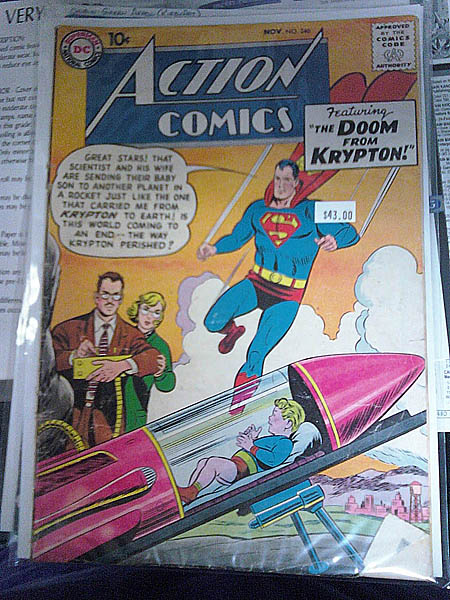
However, when I opened the original bag (a yellowed mess sealed with masking tape) I was nearly overcome by the acidic smell of decaying paper. Here’s a real heart breaker: An acidic smell that strong lowers the grade of the book, too. (The smell indicates a breakdown of the paper in the interiors.) Tan to brown pages leave this comic at a roughly-graded 3.0 (Good/Very Good) condition. Still, a book with Superman, form this time frame will be more expensive than just some random crime or romance book off the street. The Man of Steel will be going into the plexiglass storage case with the more expensive and/or vintage books (after getting a little bit of airing out.) Had the book had less of an odor to it, it could possibly have graded 4.0 or 4.5 condition. Overall, this is the kind of comic that could be of interest to a Superman fan on a budget, or as part of a Silver Age run for a collector who isn’t interested in pristine mint condition. It could make a decent reading copy, depending on your reading copy budget.
Adventure Comics #256 (1959)
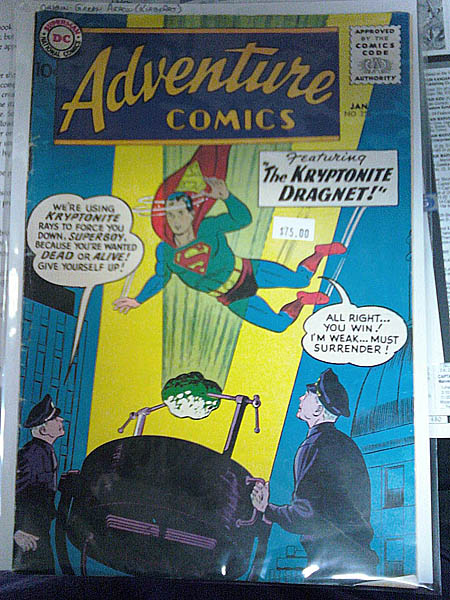
Once again, there is some damage to the spine of the book, especially around the staples, and while the edges of the cover aren’t as blunted as the Action issue, they’ve taken a beating. The interior pages, however, aren’t as brown as I expected, looking to be cream to light-tan colored. The strong acidic odor, however, works against the book, as does heavy rust on the upper staple. Grading isn’t exactly a zero-sum game when it comes to comics, and looking at the accumulation of factors here, I went with the same 3.0 (G/VG) recommendation as I did on the Action issue. It’s kind of a shame, too, as a 4.0 would have netted considerably more money in the back issue market…
The natural tendency when grading a book that you own (or one that you’re trying to sell) is to over-grade it based on it’s merits while trying to downplay it’s flaws. If I were to ignore the rust and the odor and try to price this particular issue as if it is a true 4.0, I run the risk of pricing myself out of the market, or WORSE, selling the item only to have it return to the store if someone isn’t happy with it. When you’re asking someone to buy a sealed comic, there better not be any surprises.
Captain Marvel, Jr. #31 (1944)

There is some soiling on the cover, as well as foxing (the little circles that look like mold, essentially age-spots in the paper) throughout the book, and the outer edges of the book are ragged, due to uneven trimming when the comic was printed. This book is quite clearly 2.0 (Good) condition at best, in my eyes, just from the spine damage alone, even if the rest of the book has aged relatively gracefully. The great part is, though, that a book of this age is still quite collectible in the 2.0 condition, even if nobody is going to plop down the money to have it slabbed and preserved.
This isn’t considered a highly iconic or historically important cover, nor do the interior contents prompt any comment from the Overstreet Guide. It’s a low-grade copy of a high-print-run book from the 1940’s, and might make a fine gift for someone who loves Cap Jr., wants to branch into Golden Age collecting, or someone who just wants to finally own a Golden Age comic. Your major selling point here is going to be accessibility and readability, in that you can actually peruse the stories within (I did, albeit carefully) without destroying the book’s collectibility factor.
Detective Comics #198 (1953)
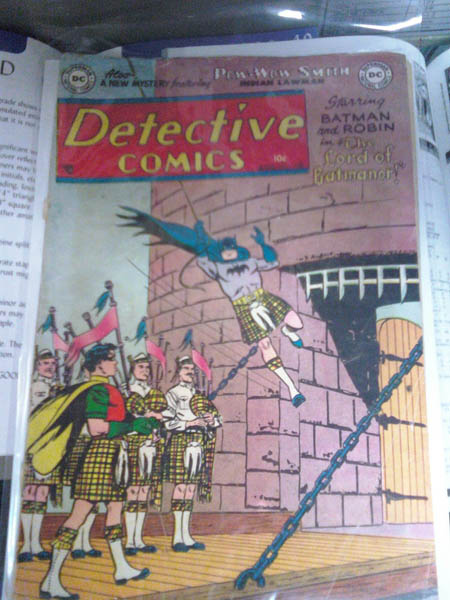
The bad news is, it’s the most damaged of the books we’ve seen yet, with extensive creasing in the cover, near detached staples, rounded corners, and a sizable rip in the back cover. The mustard-gas smell of acidic newsprint is back in spades (I admit that this one made my eyes water a bit) and our overall interiors are brittle and brown. It’s another 2.0 (G) rating, conservatively speaking, and it doesn’t have any particular historical significance (though the lead story was one of the books reprinted in Batman Annual #2 in ‘61, an issue that we also have in stock, if you’re interested.)
The good news is, it’s Batman. And Batman, regardless of era, is going to be more sought after than your average joe. This book is probably going to end up being priced $20 or more higher than the Captain Marvel, Jr. issue, despite being arguably in lesser condition, simply because it’s Batman. 1950’s Bat-tales are hard to find in any grade, so this book still has a collectibility factor to it. There’s limited soiling to the book, which is good, even in it’s advanced state of “beat-up.” The majority of vintage books I see look pretty much like this or worse.
Dell Four-Color #512 featuring Flash Gordon (1953)
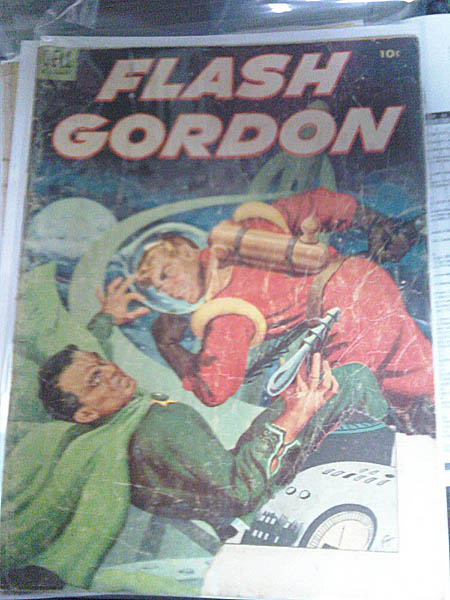
This issue is probably the most beat-up of the lot, with a cover that seems to have been crumpled and flattened at some point during it’s life, severe wear at the spine, and near detachment of the cover. The corners are rounded, and a large chunk is missing from the lower corner of the cover. All told, we’re probably looking at a 1.5 (Fair/Good) condition comic book. The real over and under here is that this is probably only going to be interesting to a Flash Gordon fan on a budget who is looking for something older as a showpiece or a reading copy.
It’s too expensive ($10 or so in a 2.0 condition) to ever go in our 3 For A Dollar Bin, and Flash Gordon isn’t the kind of high-profile character that will make this an automatic sale. But, you take the good, you take the bad, you take ‘em both and there you have The Facts Of Comics.
Superman #104 (1955)
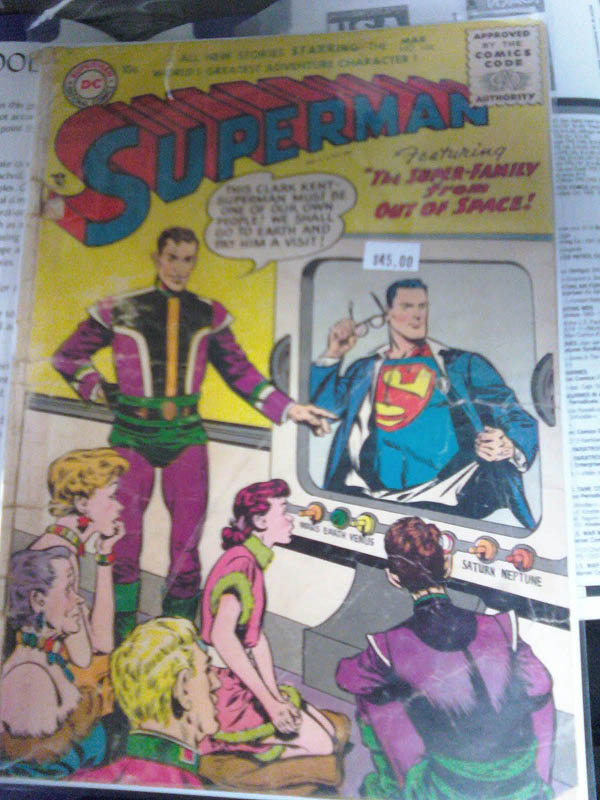
Again, the first impression of this book is the acidic newsprint smell, but soon after we can see heavy damage and wear on the cover, including some pretty horrific ripping around the upper staple. The good news is that the interiors aren’t bad as all, as the paper stock is supple and bordering on tan in color, so the cover has taken the majority of the damage. Nothing much doing in the historical importance category, so our overall composite score is about a 2.0 (Good) condition.
Superman is always going to be collectible, and we again see that this unassuming comic is much more expensive than the other books of the same time period. Given the price point, though, we’re probably looking at a book that will need to be targeted at a specific collector (we have a couple of Superman fans who might be interested) or possibly put on an online auction site to find it’s audience. I will not be surprised if this book is still in our bins three or four years from now, not because it’s not interesting, but because the general price is higher than the condition of the book would immediately indicate. We’ve had a Superman #101 in slightly better condition for some years now, looking for a good home.
World’s Finest Comics #60 (1952)

This one has some immediate flaws that catch the eye, mostly in the spine region, and a pretty nasty couple of tatters near the top. Most of the square-bound DC books have this kind of roll and split issues (it’s rare to find an 80-Page-Giant without damage to the spine) so it’s a known issue, but it’s a pretty large defect anyway. The corners of the cover are remarkably sharp, though, and the interior pages are supple and light tan in color. (The big 15 cents written on the cover wouldn’t always be considered a defect, as it was practice at many newsstands to pencil date and price information in. Still, it may lower the books appeal to a casual buyer.) Overall, we’re looking at a strong 3.0 (Good/Very Good) book here.
World’s Finest has an advantage that the Superman and Detective books we’ve seen already don’t, in that it’s collectible but doesn’t price itself out of the range of most casual buyers immediately. This comic will certainly go in our display case with the expensive titles, but it’s not going to be a 3-figure book, or one whose pricetag will immediately turn away the people who would be intersted in buying it. It’s an attractive, reasonably affordable copy of a six-decade-old title.
Most weeks aren’t as interesting as this particular batch of comics (I see a lot of MacFarlane-era Spider-Man, X-Factor V.1, Uncanny X-Men from 175 to 250, as well as various X-Crossovers from the 90’s. Also, for some reason, early issues of Gen 13…) but in any case, it’s always fascinating to pan through collections like this to pull out the little gems. The real reason I do this job isn’t for a discount, or to get first pickings, but to interact with comics that I don’t usually see or couldn’t afford to read. The real reason is because I love comics (and you do, too, and we’ll see you next time!)



